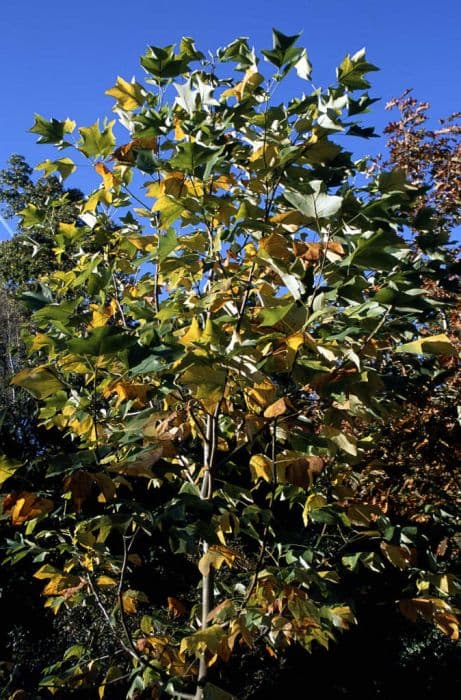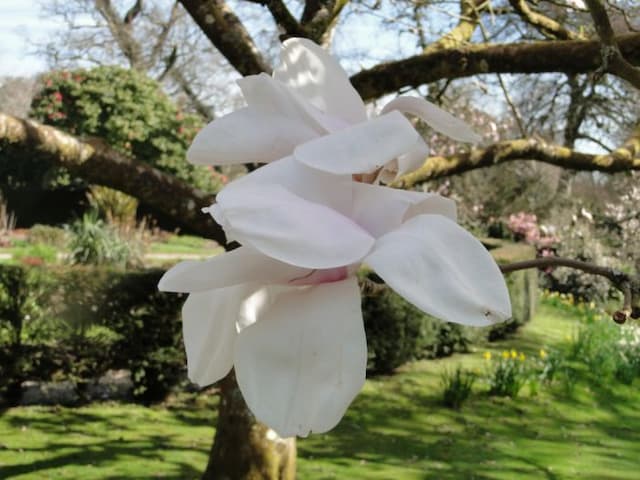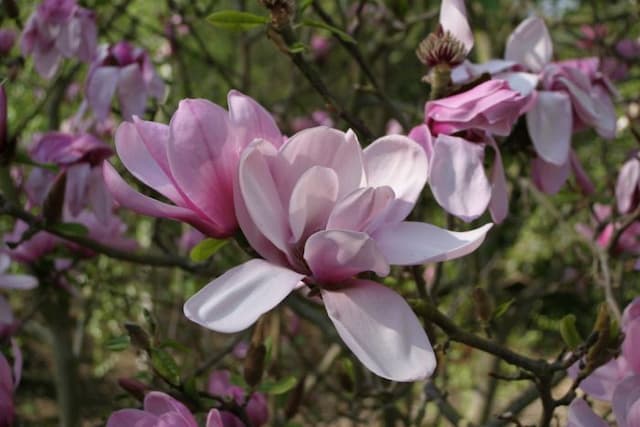Evergreen magnolia 'Kay Parris' Magnolia grandiflora 'Kay Parris'

ABOUT
'Kay Parris' is a robust, compact, free-branching evergreen shrub or small tree with glossy deep green, wavy-edged leathery, oblong-elliptic leaves, a rich rusty-brown beneath. Plentiful, highly fragrant, large cup-shaped creamy-white flowers are produced from summer to autumn
About this plant
 Names
NamesSynonyms
Kay Parris Magnolia, Southern Magnolia, Bull Bay
Common names
Magnolia grandiflora 'Kay Parris'.
 Characteristics
CharacteristicsLife cycle
Perennials
Foliage type
Evergreen
Color of leaves
Dark green
Flower color
White
Height
20 feet [6 meters]
Spread
10 feet [3 meters]
Plant type
Tree
Hardiness zones
7
Native area
Southeastern United States
Benefits
 General Benefits
General Benefits- Ornamental Appeal: Magnolia grandiflora 'Kay Parris', commonly known as Southern magnolia, has large, strikingly glossy leaves and creamy-white, fragrant flowers that add aesthetic value to landscapes.
- Shade Provider: With its broad, dense canopy, Southern magnolia offers considerable shade, making it suitable for use as a feature shade tree in gardens and parks.
- Privacy Screen: Due to its dense foliage, Southern magnolia can serve as an effective privacy screen or windbreak when planted in rows or groups.
- Erosion Control: The root system of Southern magnolia helps to stabilize soil, potentially reducing erosion on slopes or in areas prone to soil displacement.
- Attracts Wildlife: The flowers provide nectar for pollinators, while the seeds attract birds and small mammals, enhancing biodiversity in the area.
- Low Maintenance: Southern magnolia is generally resistant to pests and diseases and requires relatively low upkeep once established, making it a convenient choice for gardeners of all skill levels.
- Year-Round Interest: Evergreen foliage ensures that Southern magnolia retains visual interest throughout the entire year, even during the colder months.
- Drought Tolerance: Once established, this variety of magnolia is tolerant of drought conditions, making it a practical option in water-restricted areas.
- Adaptability: Southern magnolia can adapt to a range of soil types, although it prefers well-drained, slightly acidic soils.
 Medical Properties
Medical PropertiesThis plant is not used for medical purposes.
 Air-purifying Qualities
Air-purifying QualitiesThis plant is not specifically known for air purifying qualities.
 Other Uses
Other Uses- Magnolia leaves can be used in floral arrangements or wreaths, providing a lush, glossy green backdrop with a southern charm.
- The strong wood of the Magnolia tree is sometimes used in furniture making, although it's not a common timber due to its specific growing conditions.
- The thick, leathery leaves can be used as a natural mulch in gardens, slowly breaking down and enriching the soil with nutrients.
- Dried Magnolia seed pods can be incorporated into decorative crafts, such as table centerpieces, providing a rustic aesthetic.
- The bark of the Magnolia has been traditionally used for creating plant dyes, offering a range of colors from green to brown depending on the mordant used.
- Magnolia flowers can be crystallized with sugar and used as edible decorations on desserts, although they are not commonly eaten.
- The cones of the Magnolia, once dried, can serve as fire starters due to their resinous properties.
- Leaves of the Magnolia can be used in the art of leaf etching to create delicate patterns and designs for artistic projects.
- The dense foliage of the Magnolia provides excellent privacy screening in landscapes where a natural barrier is desired.
- While not a primary use, the dried leaves and branches of Magnolia are occasionally used in the construction of bird nests by various bird species.
Interesting Facts
 Feng Shui
Feng ShuiThe Southern magnolia is not used in Feng Shui practice.
 Zodiac Sign Compitability
Zodiac Sign CompitabilityThe Southern magnolia is not used in astrology practice.
 Plant Symbolism
Plant Symbolism- Dignity: The Magnolia grandiflora, commonly known as the Southern magnolia, often represents a sense of nobility and self-respect due to its grand appearance and impressive size.
- Perseverance: This plant is known for its hardiness and ability to withstand varying conditions, symbolizing the human capacity to endure and persist through challenges.
- Feminine Beauty: With its large, creamy white flowers and delicate scent, the Southern magnolia is traditionally associated with the purity and gentle beauty of femininity.
- Hospitality: In the South, the Southern magnolia is often planted around homes as a sign of welcoming and graciousness to guests, reflecting the warmth of the homeowner.
- Longevity: The Southern magnolia tree can live for a century or more, symbolizing long life and continuity.
 Water
WaterThe Southern Magnolia should be watered deeply, allowing the soil to partially dry between waterings. For young trees, water weekly with about 1.5 gallons per inch of trunk diameter. Mature trees, however, require less frequent watering, depending on weather conditions. During hot, dry spells, a deep watering every two to three weeks may be necessary. Be careful not to overwater as this species does not tolerate soggy soil.
 Light
LightSouthern Magnolias thrive in full sun to partial shade. They perform best in a location that receives direct sunlight for at least four to six hours a day. Avoid deep shade areas as insufficient light can lead to fewer flowers and a less dense canopy.
 Temperature
TemperatureSouthern Magnolias are hardy and can withstand a temperature range from about zero to over 100 degrees Fahrenheit. The ideal growing temperatures for this magnolia are between 70 to 90 degrees Fahrenheit during the growing season. They are resilient to brief periods of chill but should be protected from extreme cold when young.
 Pruning
PruningPrune your Southern Magnolia to maintain its shape and remove any dead or damaged limbs. The best time to prune is in the late spring after the flowering season has ended. Pruning once a year is usually sufficient unless there are broken or diseased branches, which should be removed as needed.
 Soil
SoilThe Southern Magnolia 'Kay Parris' thrives in well-draining, rich soil that is slightly acidic, with an ideal pH range of 5.0 to 6.5. A good mix would include loamy soil, compost, and pine bark to ensure nutrient richness and proper drainage.
 Repotting
Repotting'Kay Parris' Southern Magnolias, when grown in containers, should be repotted every 2-3 years, or when they outgrow their current pot, to allow for continued growth and root expansion.
 Humidity & Misting
Humidity & Misting'Kay Parris' Southern Magnolias fare well in average outdoor humidity; if grown indoors, they don't require any special humidity adjustments.
 Suitable locations
Suitable locationsIndoor
Place in bright, indirect light with ample space.
Outdoor
Choose a sunny spot with moist, well-draining soil.
Hardiness zone
7-10 USDA
 Life cycle
Life cycleThe life of 'Kay Parris' Southern Magnolia begins with seed germination, where a seedling emerges after stratification, which is a period of cold temperatures to break dormancy. As the seedling grows, it enters the vegetative stage, developing leaves and establishing a root system. The plant progresses to the sapling stage as it develops a woody stem and branches, typically reaching flowering maturity within 10 to 15 years. The reproductive stage commences when the plant produces its characteristic large, fragrant white flowers in the spring and summer, followed by cone-like fruit that contains red seeds dispersed by birds and mammals. After the reproductive phase, the plant continues to grow and produce flowers annually. With a lifespan that can extend over a century, 'Kay Parris' Southern Magnolia eventually enters a period of senescence, where growth slows and the tree may become more susceptible to disease and environmental stress before dying.
 Propogation
PropogationPropogation time
Spring-Early Summer
The Southern Magnolia 'Kay Parris' can be propagated effectively through semi-hardwood cuttings, a method that is both practical and commonly employed by gardeners. This entails taking cuttings of new growth that has begun to mature and harden slightly, typically in late summer or early fall. The cuttings, usually about 4 to 6 inches (10 to 15 centimeters) long, should include at least one node, and the leaves on the lower half should be removed. To encourage root development, the cut end is often dipped in a rooting hormone before being placed in a well-draining rooting medium. It is then important to maintain a humid environment, which can be achieved with a plastic cover, until roots have sufficiently formed to allow transplantation into the garden or a larger pot.









![Magnolia [Felix Jury]](/_next/image?url=https%3A%2F%2Fplants-admin.emdemapps.com%2Fimages%2Fplants%2F%2Fimages%2F604b61a0b23b7.png&w=640&q=75)